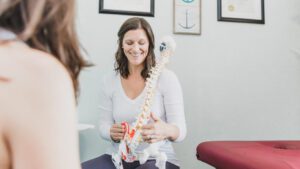To do so, first we must understand where headaches come from.
Headaches happen to be one of the most frequent complaints we see in our office. Oftentimes, individuals come in with other complaints but check the box for “headaches” without much thought. Upon questioning, we often hear reports of weekly if not daily head pain. Other times, people report having suffered from migraines since high school or college.
Our questioning often goes like this:
-“How often do you experience a headache?”
-“How would you rate your pain, on a scale of 1-10?”
-“Where is your headache located?”
-“Do you have visual disturbances or sensitivities?”
-“What medications do you take and do they help?”
-“Have you had any trauma? Car accident, fall skiing, slip does stairs or ice? Did you play any contact sports?”
-“What do you do for work?”
-“Any pelvic floor symptoms: Leakage with jumping, couching, laughing, sneezing?; Pain with sex or vaginal penetration?; Heaviness?”
What do these questions tell us?
For one, those who report migraines without visual disturbance, sensitivities or nausea/vomiting more than likely do not have true migraines. We often take this opportunity to educate individuals on the physiologic event around migraines (historically thought to be related to some kind of vascular compromise).
Interestingly, headaches can mimic migraines causing head pain, visual disturbances, nausea/vomiting and sensitivities. The only difference is that headaches do not usually respond to the typical cocktails of medications that migraines do. Triptans, or drugs that are commonly used to treat migraines, do not relieve pain for those suffering from a headache, often.
The answers to this question also give us insight into the etiology (origination) of symptoms. If a person responds that they have had trauma, ever, we are looking at the neck as a probable cause of head pain. If a car accident is reported, it is even stronger. A speed of 4 miles per hour is required to cause whiplash, and whiplash can have a delayed affect in the head and neck.
Additionally, those who spend a lot of time on their computer or cell phone have increased likelihood of dealing with headaches or migraines. Especially
Headaches are complex.
Headaches aren’t as simple as many think. Yes, they can come from sinuses. Or a hangover. And frequently, dehydration. But something that we don’t often consider is the origin in the neck. The cervical spine (the neck) is composed of vertebrae and muscles whose job is to keep the head vertical. Even more interesting is the relationship between the brain and the muscles of the neck. A reflex called the Vestibular Ocular Reflex (VOR) and the Vestibulospinal Reflex (VSR) are responsible for coordinating the position of the head on top of neck in order to assist the eyes in focusing and maintaining upright position.
The VOR intricately involves the muscles of the head and neck. In order to keep the eyes in focus on an object, the muscles of the neck must work to control the head. The muscles surrounding the eyes are of utmost importance in this situation, as they control the eyes position in relation to the horizon.
So what can be done about head pain?
Here are my the top 5 recommendations we often start with:
- Pay attention to posture while performing activities of daily living. This includes your form while working out, how you’re seated at your desk or what you do when you’re driving your car.
- Stop “cracking” your neck. Many people who deal with headaches after feel as though their necks are tight and need to be “cracked.” While this does alleviate pain and provides a short-term burst of euphoria, in the long run, we are creating more instability through the soft tissue that support the spine.
- Be mindful of how certain foods/drinks make you feel. Unfortunately, our bodies do not always process food and beverages that we consume and can trigger the nervous system to be alarmed. Watching your consumption and noting how your head and neck feel can be very enlightening.
- Begin a mindfulness/relaxation routine. Individuals will often carry stress in their neck so making sure to re-establish a resting baseline for your stress on a daily basis is important.
- Get better sleep. Deep rest is important for the function and recovery of soft tissue, including muscles. Ensuring adequate deep sleep is very helpful when addressing any sort of chronic or persistent pain.
Additionally, a Physical Therapy consult is a great tool to identify underlying dysfunction and to put together a long term plan to overcome pain.
About the author:

Dr. Sarah Cash Crawford, PT, DPT, COMT, CMTPT, is a Physical Therapist and Certified Pilates Instructor. She has been a practicing physical therapy for over 10 years. With a background in neurologic rehabilitation, manual therapy and a specialty in treating chronic pain, Dr. Crawford has advanced training in orthopedic manual physical therapy and holds a certification in Geoffrey Maitland’s approach.
She was also the first student certified by Myopain Seminars in Dry Needling, holding her Certified Myofascial Trigger Point Therapist credentials since 2014. Dr. Crawford studied Pilates early in her practice to further expand her treatment options to help patients overcome physical limitations. Dr. Crawford is the founder of the Anchor Wellness Center, an integrated health and wellness collaborative.

